Business Communication Report: Tesco and Information Types
VerifiedAdded on 2020/07/23
|8
|2223
|36
Report
AI Summary
This report analyzes business communication within the context of Tesco, a leading retail corporation. It explores various types of business information, including verbal and written communication, and their sources. The report examines external corporate communications, evaluating how Tesco informs customers and communicates pricing and promotions. It delves into the legal and ethical issues related to business information, referencing relevant UK legislation such as the Data Protection Act and the Freedom of Information Act. Operational issues, including information security and health and safety, are also discussed. The report outlines both electronic and non-electronic methods for communicating business information, offering insights into effective communication strategies. The report concludes with a summary of the key findings and a list of references.
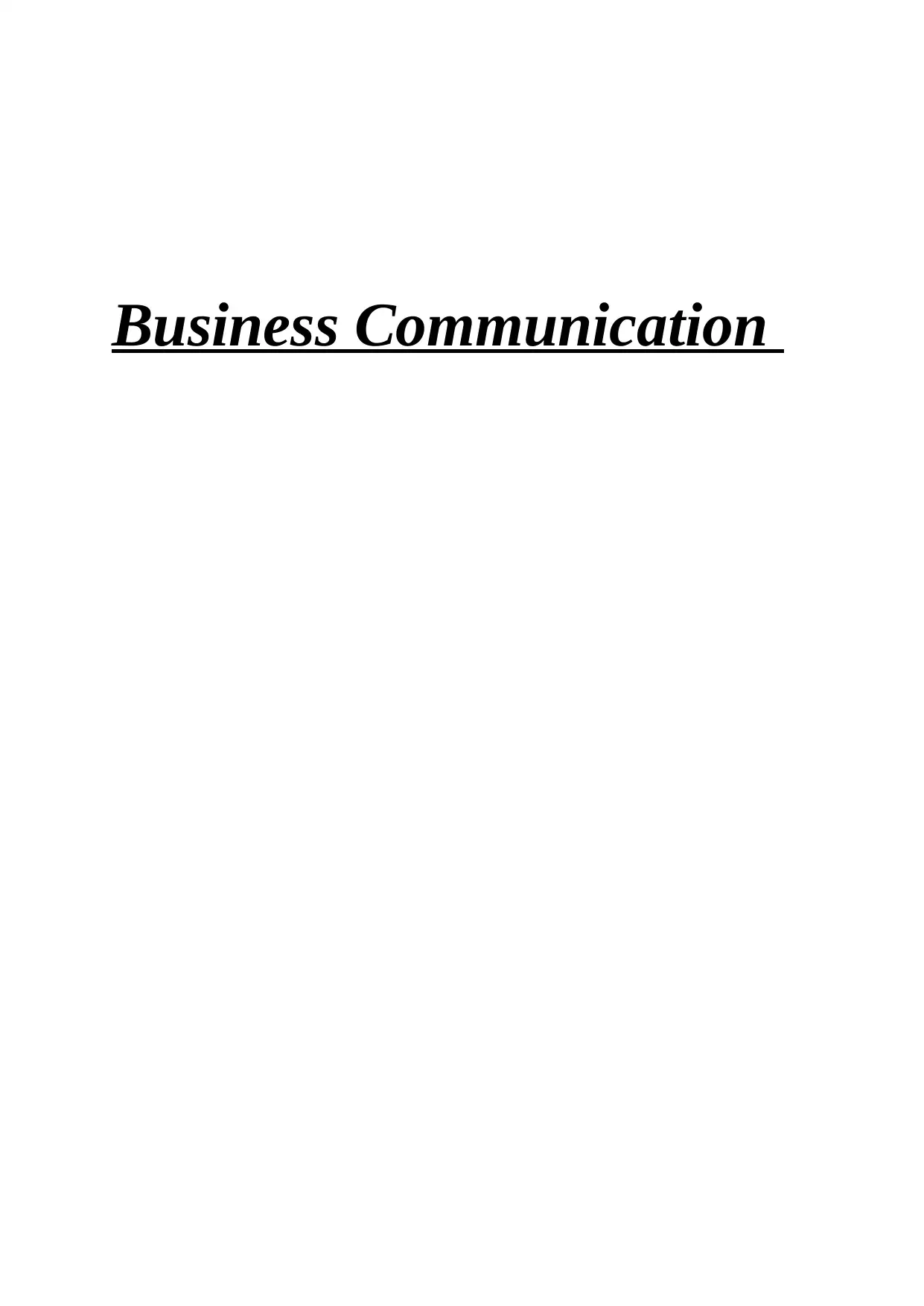
Business Communication
Paraphrase This Document
Need a fresh take? Get an instant paraphrase of this document with our AI Paraphraser
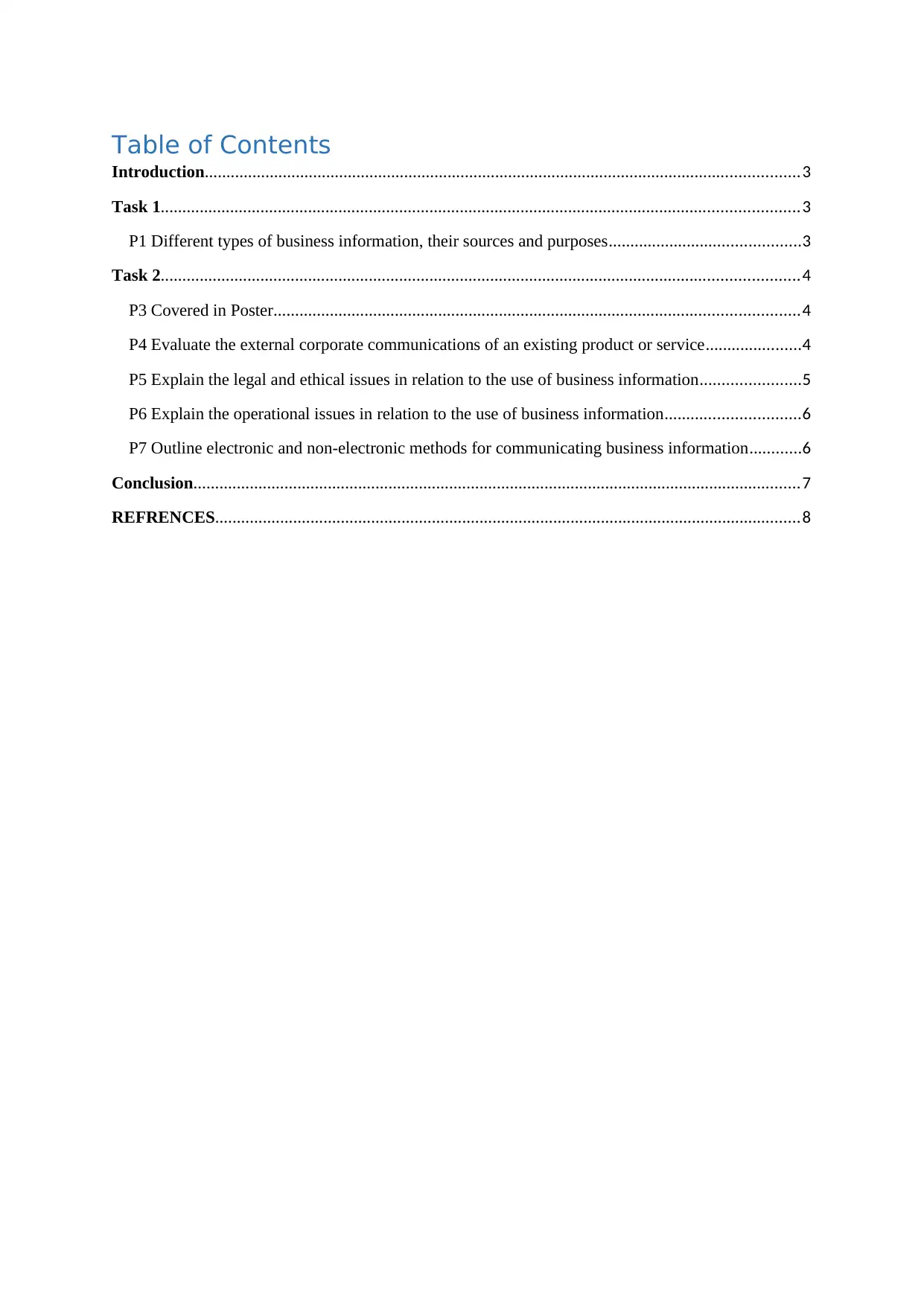
Table of Contents
Introduction.........................................................................................................................................3
Task 1...................................................................................................................................................3
P1 Different types of business information, their sources and purposes............................................3
Task 2...................................................................................................................................................4
P3 Covered in Poster.........................................................................................................................4
P4 Evaluate the external corporate communications of an existing product or service......................4
P5 Explain the legal and ethical issues in relation to the use of business information.......................5
P6 Explain the operational issues in relation to the use of business information...............................6
P7 Outline electronic and non-electronic methods for communicating business information............6
Conclusion............................................................................................................................................7
REFRENCES.......................................................................................................................................8
Introduction.........................................................................................................................................3
Task 1...................................................................................................................................................3
P1 Different types of business information, their sources and purposes............................................3
Task 2...................................................................................................................................................4
P3 Covered in Poster.........................................................................................................................4
P4 Evaluate the external corporate communications of an existing product or service......................4
P5 Explain the legal and ethical issues in relation to the use of business information.......................5
P6 Explain the operational issues in relation to the use of business information...............................6
P7 Outline electronic and non-electronic methods for communicating business information............6
Conclusion............................................................................................................................................7
REFRENCES.......................................................................................................................................8
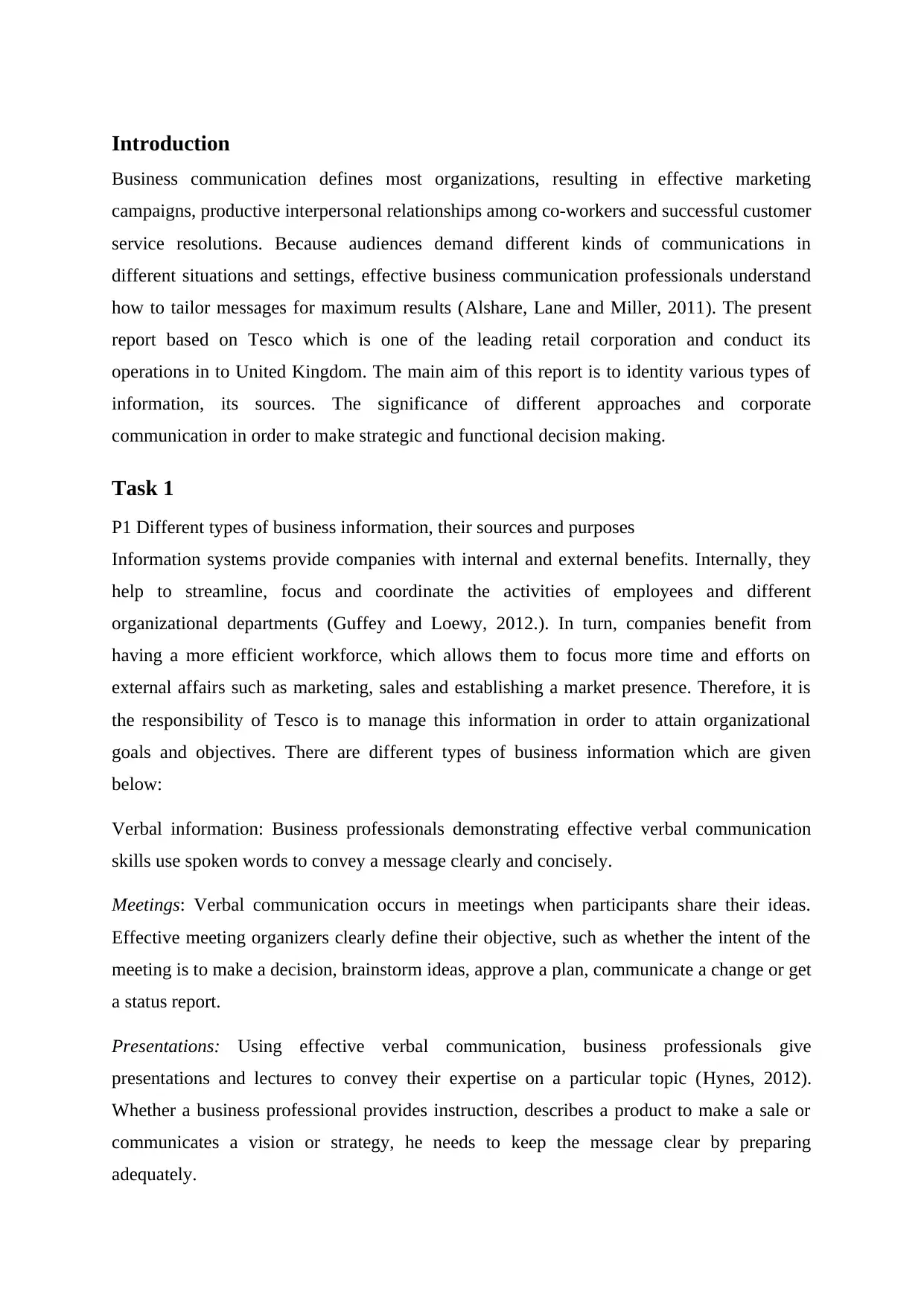
Introduction
Business communication defines most organizations, resulting in effective marketing
campaigns, productive interpersonal relationships among co-workers and successful customer
service resolutions. Because audiences demand different kinds of communications in
different situations and settings, effective business communication professionals understand
how to tailor messages for maximum results (Alshare, Lane and Miller, 2011). The present
report based on Tesco which is one of the leading retail corporation and conduct its
operations in to United Kingdom. The main aim of this report is to identity various types of
information, its sources. The significance of different approaches and corporate
communication in order to make strategic and functional decision making.
Task 1
P1 Different types of business information, their sources and purposes
Information systems provide companies with internal and external benefits. Internally, they
help to streamline, focus and coordinate the activities of employees and different
organizational departments (Guffey and Loewy, 2012.). In turn, companies benefit from
having a more efficient workforce, which allows them to focus more time and efforts on
external affairs such as marketing, sales and establishing a market presence. Therefore, it is
the responsibility of Tesco is to manage this information in order to attain organizational
goals and objectives. There are different types of business information which are given
below:
Verbal information: Business professionals demonstrating effective verbal communication
skills use spoken words to convey a message clearly and concisely.
Meetings: Verbal communication occurs in meetings when participants share their ideas.
Effective meeting organizers clearly define their objective, such as whether the intent of the
meeting is to make a decision, brainstorm ideas, approve a plan, communicate a change or get
a status report.
Presentations: Using effective verbal communication, business professionals give
presentations and lectures to convey their expertise on a particular topic (Hynes, 2012).
Whether a business professional provides instruction, describes a product to make a sale or
communicates a vision or strategy, he needs to keep the message clear by preparing
adequately.
Business communication defines most organizations, resulting in effective marketing
campaigns, productive interpersonal relationships among co-workers and successful customer
service resolutions. Because audiences demand different kinds of communications in
different situations and settings, effective business communication professionals understand
how to tailor messages for maximum results (Alshare, Lane and Miller, 2011). The present
report based on Tesco which is one of the leading retail corporation and conduct its
operations in to United Kingdom. The main aim of this report is to identity various types of
information, its sources. The significance of different approaches and corporate
communication in order to make strategic and functional decision making.
Task 1
P1 Different types of business information, their sources and purposes
Information systems provide companies with internal and external benefits. Internally, they
help to streamline, focus and coordinate the activities of employees and different
organizational departments (Guffey and Loewy, 2012.). In turn, companies benefit from
having a more efficient workforce, which allows them to focus more time and efforts on
external affairs such as marketing, sales and establishing a market presence. Therefore, it is
the responsibility of Tesco is to manage this information in order to attain organizational
goals and objectives. There are different types of business information which are given
below:
Verbal information: Business professionals demonstrating effective verbal communication
skills use spoken words to convey a message clearly and concisely.
Meetings: Verbal communication occurs in meetings when participants share their ideas.
Effective meeting organizers clearly define their objective, such as whether the intent of the
meeting is to make a decision, brainstorm ideas, approve a plan, communicate a change or get
a status report.
Presentations: Using effective verbal communication, business professionals give
presentations and lectures to convey their expertise on a particular topic (Hynes, 2012).
Whether a business professional provides instruction, describes a product to make a sale or
communicates a vision or strategy, he needs to keep the message clear by preparing
adequately.
⊘ This is a preview!⊘
Do you want full access?
Subscribe today to unlock all pages.

Trusted by 1+ million students worldwide
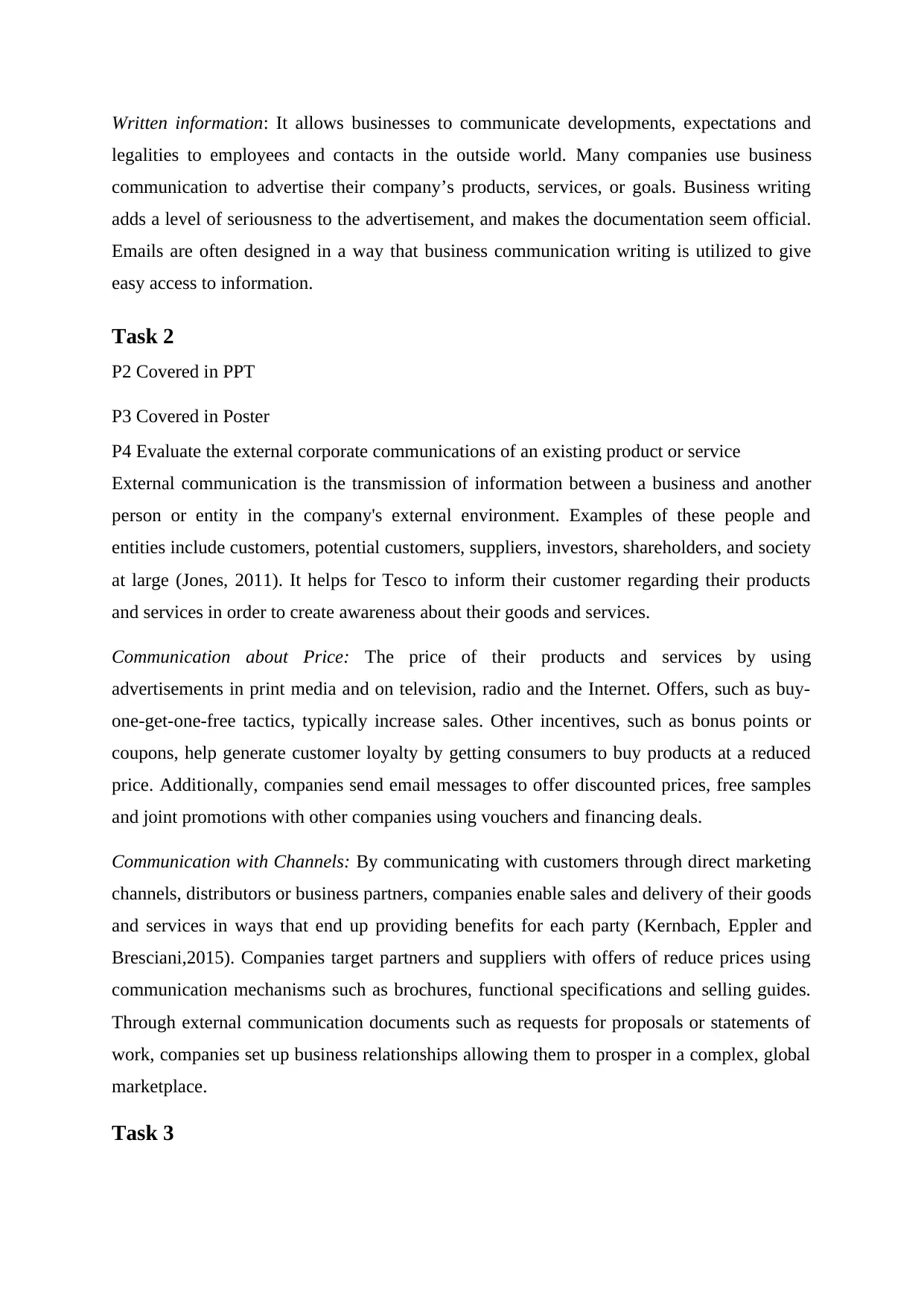
Written information: It allows businesses to communicate developments, expectations and
legalities to employees and contacts in the outside world. Many companies use business
communication to advertise their company’s products, services, or goals. Business writing
adds a level of seriousness to the advertisement, and makes the documentation seem official.
Emails are often designed in a way that business communication writing is utilized to give
easy access to information.
Task 2
P2 Covered in PPT
P3 Covered in Poster
P4 Evaluate the external corporate communications of an existing product or service
External communication is the transmission of information between a business and another
person or entity in the company's external environment. Examples of these people and
entities include customers, potential customers, suppliers, investors, shareholders, and society
at large (Jones, 2011). It helps for Tesco to inform their customer regarding their products
and services in order to create awareness about their goods and services.
Communication about Price: The price of their products and services by using
advertisements in print media and on television, radio and the Internet. Offers, such as buy-
one-get-one-free tactics, typically increase sales. Other incentives, such as bonus points or
coupons, help generate customer loyalty by getting consumers to buy products at a reduced
price. Additionally, companies send email messages to offer discounted prices, free samples
and joint promotions with other companies using vouchers and financing deals.
Communication with Channels: By communicating with customers through direct marketing
channels, distributors or business partners, companies enable sales and delivery of their goods
and services in ways that end up providing benefits for each party (Kernbach, Eppler and
Bresciani,2015). Companies target partners and suppliers with offers of reduce prices using
communication mechanisms such as brochures, functional specifications and selling guides.
Through external communication documents such as requests for proposals or statements of
work, companies set up business relationships allowing them to prosper in a complex, global
marketplace.
Task 3
legalities to employees and contacts in the outside world. Many companies use business
communication to advertise their company’s products, services, or goals. Business writing
adds a level of seriousness to the advertisement, and makes the documentation seem official.
Emails are often designed in a way that business communication writing is utilized to give
easy access to information.
Task 2
P2 Covered in PPT
P3 Covered in Poster
P4 Evaluate the external corporate communications of an existing product or service
External communication is the transmission of information between a business and another
person or entity in the company's external environment. Examples of these people and
entities include customers, potential customers, suppliers, investors, shareholders, and society
at large (Jones, 2011). It helps for Tesco to inform their customer regarding their products
and services in order to create awareness about their goods and services.
Communication about Price: The price of their products and services by using
advertisements in print media and on television, radio and the Internet. Offers, such as buy-
one-get-one-free tactics, typically increase sales. Other incentives, such as bonus points or
coupons, help generate customer loyalty by getting consumers to buy products at a reduced
price. Additionally, companies send email messages to offer discounted prices, free samples
and joint promotions with other companies using vouchers and financing deals.
Communication with Channels: By communicating with customers through direct marketing
channels, distributors or business partners, companies enable sales and delivery of their goods
and services in ways that end up providing benefits for each party (Kernbach, Eppler and
Bresciani,2015). Companies target partners and suppliers with offers of reduce prices using
communication mechanisms such as brochures, functional specifications and selling guides.
Through external communication documents such as requests for proposals or statements of
work, companies set up business relationships allowing them to prosper in a complex, global
marketplace.
Task 3
Paraphrase This Document
Need a fresh take? Get an instant paraphrase of this document with our AI Paraphraser
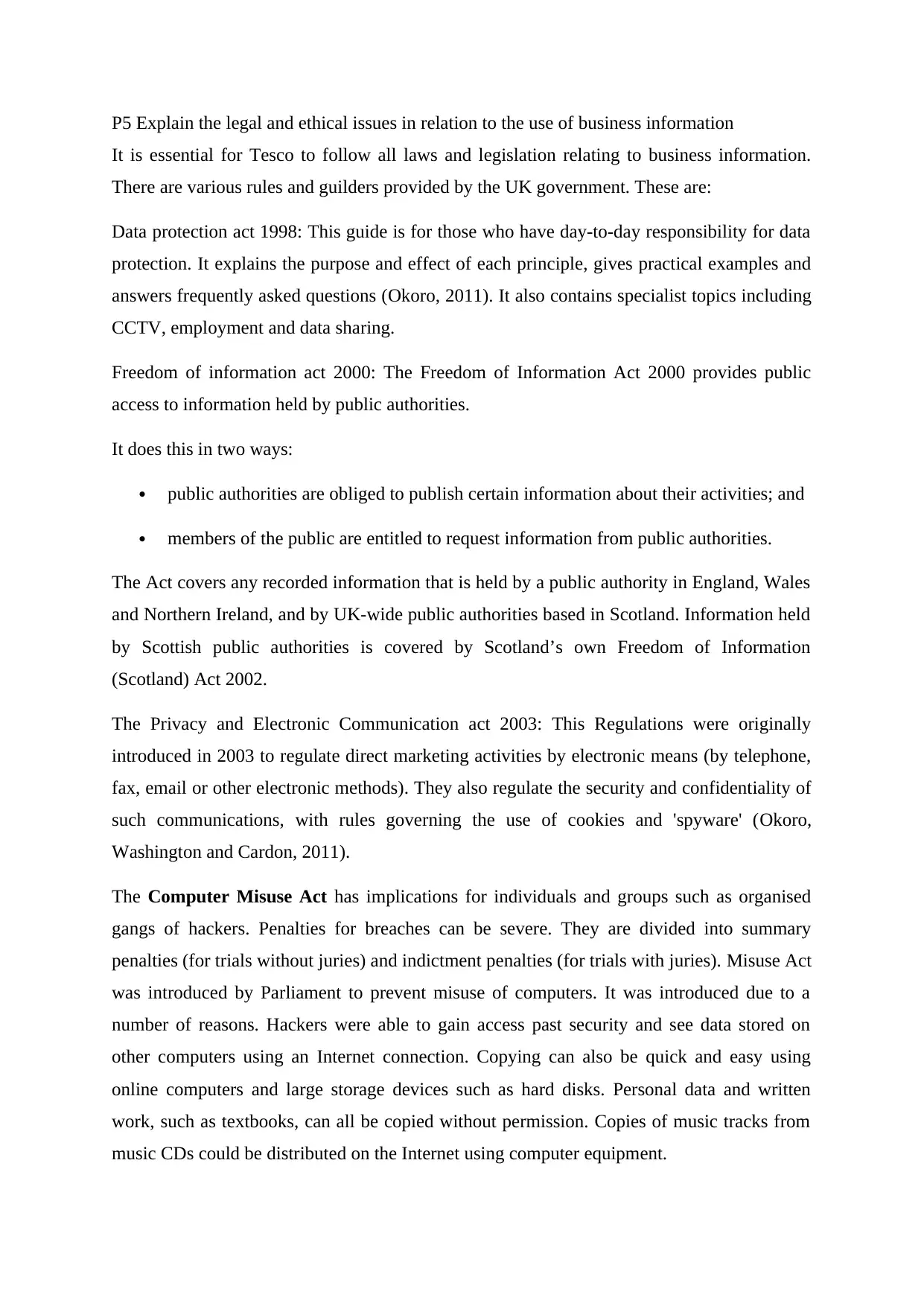
P5 Explain the legal and ethical issues in relation to the use of business information
It is essential for Tesco to follow all laws and legislation relating to business information.
There are various rules and guilders provided by the UK government. These are:
Data protection act 1998: This guide is for those who have day-to-day responsibility for data
protection. It explains the purpose and effect of each principle, gives practical examples and
answers frequently asked questions (Okoro, 2011). It also contains specialist topics including
CCTV, employment and data sharing.
Freedom of information act 2000: The Freedom of Information Act 2000 provides public
access to information held by public authorities.
It does this in two ways:
public authorities are obliged to publish certain information about their activities; and
members of the public are entitled to request information from public authorities.
The Act covers any recorded information that is held by a public authority in England, Wales
and Northern Ireland, and by UK-wide public authorities based in Scotland. Information held
by Scottish public authorities is covered by Scotland’s own Freedom of Information
(Scotland) Act 2002.
The Privacy and Electronic Communication act 2003: This Regulations were originally
introduced in 2003 to regulate direct marketing activities by electronic means (by telephone,
fax, email or other electronic methods). They also regulate the security and confidentiality of
such communications, with rules governing the use of cookies and 'spyware' (Okoro,
Washington and Cardon, 2011).
The Computer Misuse Act has implications for individuals and groups such as organised
gangs of hackers. Penalties for breaches can be severe. They are divided into summary
penalties (for trials without juries) and indictment penalties (for trials with juries). Misuse Act
was introduced by Parliament to prevent misuse of computers. It was introduced due to a
number of reasons. Hackers were able to gain access past security and see data stored on
other computers using an Internet connection. Copying can also be quick and easy using
online computers and large storage devices such as hard disks. Personal data and written
work, such as textbooks, can all be copied without permission. Copies of music tracks from
music CDs could be distributed on the Internet using computer equipment.
It is essential for Tesco to follow all laws and legislation relating to business information.
There are various rules and guilders provided by the UK government. These are:
Data protection act 1998: This guide is for those who have day-to-day responsibility for data
protection. It explains the purpose and effect of each principle, gives practical examples and
answers frequently asked questions (Okoro, 2011). It also contains specialist topics including
CCTV, employment and data sharing.
Freedom of information act 2000: The Freedom of Information Act 2000 provides public
access to information held by public authorities.
It does this in two ways:
public authorities are obliged to publish certain information about their activities; and
members of the public are entitled to request information from public authorities.
The Act covers any recorded information that is held by a public authority in England, Wales
and Northern Ireland, and by UK-wide public authorities based in Scotland. Information held
by Scottish public authorities is covered by Scotland’s own Freedom of Information
(Scotland) Act 2002.
The Privacy and Electronic Communication act 2003: This Regulations were originally
introduced in 2003 to regulate direct marketing activities by electronic means (by telephone,
fax, email or other electronic methods). They also regulate the security and confidentiality of
such communications, with rules governing the use of cookies and 'spyware' (Okoro,
Washington and Cardon, 2011).
The Computer Misuse Act has implications for individuals and groups such as organised
gangs of hackers. Penalties for breaches can be severe. They are divided into summary
penalties (for trials without juries) and indictment penalties (for trials with juries). Misuse Act
was introduced by Parliament to prevent misuse of computers. It was introduced due to a
number of reasons. Hackers were able to gain access past security and see data stored on
other computers using an Internet connection. Copying can also be quick and easy using
online computers and large storage devices such as hard disks. Personal data and written
work, such as textbooks, can all be copied without permission. Copies of music tracks from
music CDs could be distributed on the Internet using computer equipment.
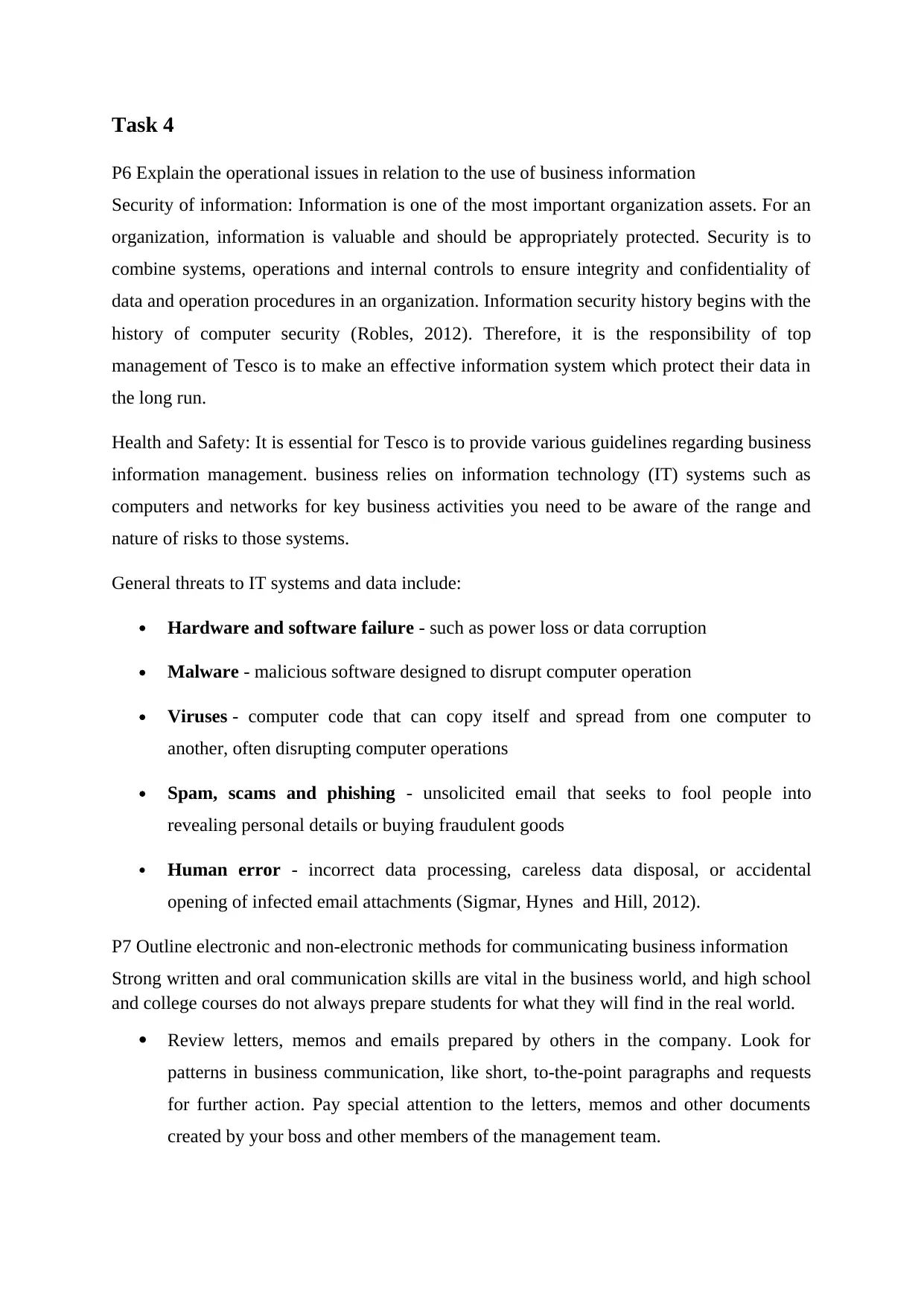
Task 4
P6 Explain the operational issues in relation to the use of business information
Security of information: Information is one of the most important organization assets. For an
organization, information is valuable and should be appropriately protected. Security is to
combine systems, operations and internal controls to ensure integrity and confidentiality of
data and operation procedures in an organization. Information security history begins with the
history of computer security (Robles, 2012). Therefore, it is the responsibility of top
management of Tesco is to make an effective information system which protect their data in
the long run.
Health and Safety: It is essential for Tesco is to provide various guidelines regarding business
information management. business relies on information technology (IT) systems such as
computers and networks for key business activities you need to be aware of the range and
nature of risks to those systems.
General threats to IT systems and data include:
Hardware and software failure - such as power loss or data corruption
Malware - malicious software designed to disrupt computer operation
Viruses - computer code that can copy itself and spread from one computer to
another, often disrupting computer operations
Spam, scams and phishing - unsolicited email that seeks to fool people into
revealing personal details or buying fraudulent goods
Human error - incorrect data processing, careless data disposal, or accidental
opening of infected email attachments (Sigmar, Hynes and Hill, 2012).
P7 Outline electronic and non-electronic methods for communicating business information
Strong written and oral communication skills are vital in the business world, and high school
and college courses do not always prepare students for what they will find in the real world.
Review letters, memos and emails prepared by others in the company. Look for
patterns in business communication, like short, to-the-point paragraphs and requests
for further action. Pay special attention to the letters, memos and other documents
created by your boss and other members of the management team.
P6 Explain the operational issues in relation to the use of business information
Security of information: Information is one of the most important organization assets. For an
organization, information is valuable and should be appropriately protected. Security is to
combine systems, operations and internal controls to ensure integrity and confidentiality of
data and operation procedures in an organization. Information security history begins with the
history of computer security (Robles, 2012). Therefore, it is the responsibility of top
management of Tesco is to make an effective information system which protect their data in
the long run.
Health and Safety: It is essential for Tesco is to provide various guidelines regarding business
information management. business relies on information technology (IT) systems such as
computers and networks for key business activities you need to be aware of the range and
nature of risks to those systems.
General threats to IT systems and data include:
Hardware and software failure - such as power loss or data corruption
Malware - malicious software designed to disrupt computer operation
Viruses - computer code that can copy itself and spread from one computer to
another, often disrupting computer operations
Spam, scams and phishing - unsolicited email that seeks to fool people into
revealing personal details or buying fraudulent goods
Human error - incorrect data processing, careless data disposal, or accidental
opening of infected email attachments (Sigmar, Hynes and Hill, 2012).
P7 Outline electronic and non-electronic methods for communicating business information
Strong written and oral communication skills are vital in the business world, and high school
and college courses do not always prepare students for what they will find in the real world.
Review letters, memos and emails prepared by others in the company. Look for
patterns in business communication, like short, to-the-point paragraphs and requests
for further action. Pay special attention to the letters, memos and other documents
created by your boss and other members of the management team.
⊘ This is a preview!⊘
Do you want full access?
Subscribe today to unlock all pages.

Trusted by 1+ million students worldwide
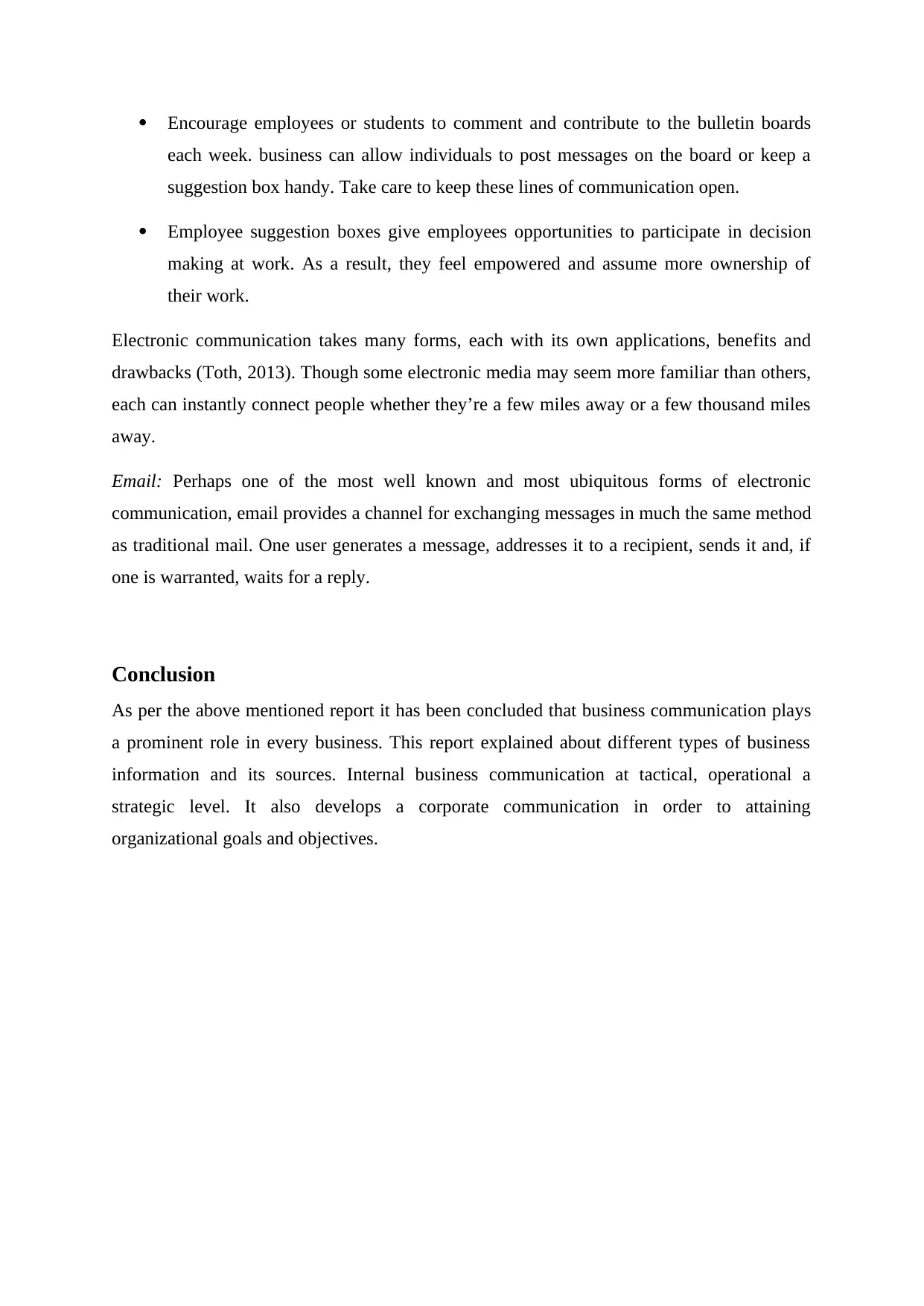
Encourage employees or students to comment and contribute to the bulletin boards
each week. business can allow individuals to post messages on the board or keep a
suggestion box handy. Take care to keep these lines of communication open.
Employee suggestion boxes give employees opportunities to participate in decision
making at work. As a result, they feel empowered and assume more ownership of
their work.
Electronic communication takes many forms, each with its own applications, benefits and
drawbacks (Toth, 2013). Though some electronic media may seem more familiar than others,
each can instantly connect people whether they’re a few miles away or a few thousand miles
away.
Email: Perhaps one of the most well known and most ubiquitous forms of electronic
communication, email provides a channel for exchanging messages in much the same method
as traditional mail. One user generates a message, addresses it to a recipient, sends it and, if
one is warranted, waits for a reply.
Conclusion
As per the above mentioned report it has been concluded that business communication plays
a prominent role in every business. This report explained about different types of business
information and its sources. Internal business communication at tactical, operational a
strategic level. It also develops a corporate communication in order to attaining
organizational goals and objectives.
each week. business can allow individuals to post messages on the board or keep a
suggestion box handy. Take care to keep these lines of communication open.
Employee suggestion boxes give employees opportunities to participate in decision
making at work. As a result, they feel empowered and assume more ownership of
their work.
Electronic communication takes many forms, each with its own applications, benefits and
drawbacks (Toth, 2013). Though some electronic media may seem more familiar than others,
each can instantly connect people whether they’re a few miles away or a few thousand miles
away.
Email: Perhaps one of the most well known and most ubiquitous forms of electronic
communication, email provides a channel for exchanging messages in much the same method
as traditional mail. One user generates a message, addresses it to a recipient, sends it and, if
one is warranted, waits for a reply.
Conclusion
As per the above mentioned report it has been concluded that business communication plays
a prominent role in every business. This report explained about different types of business
information and its sources. Internal business communication at tactical, operational a
strategic level. It also develops a corporate communication in order to attaining
organizational goals and objectives.
Paraphrase This Document
Need a fresh take? Get an instant paraphrase of this document with our AI Paraphraser
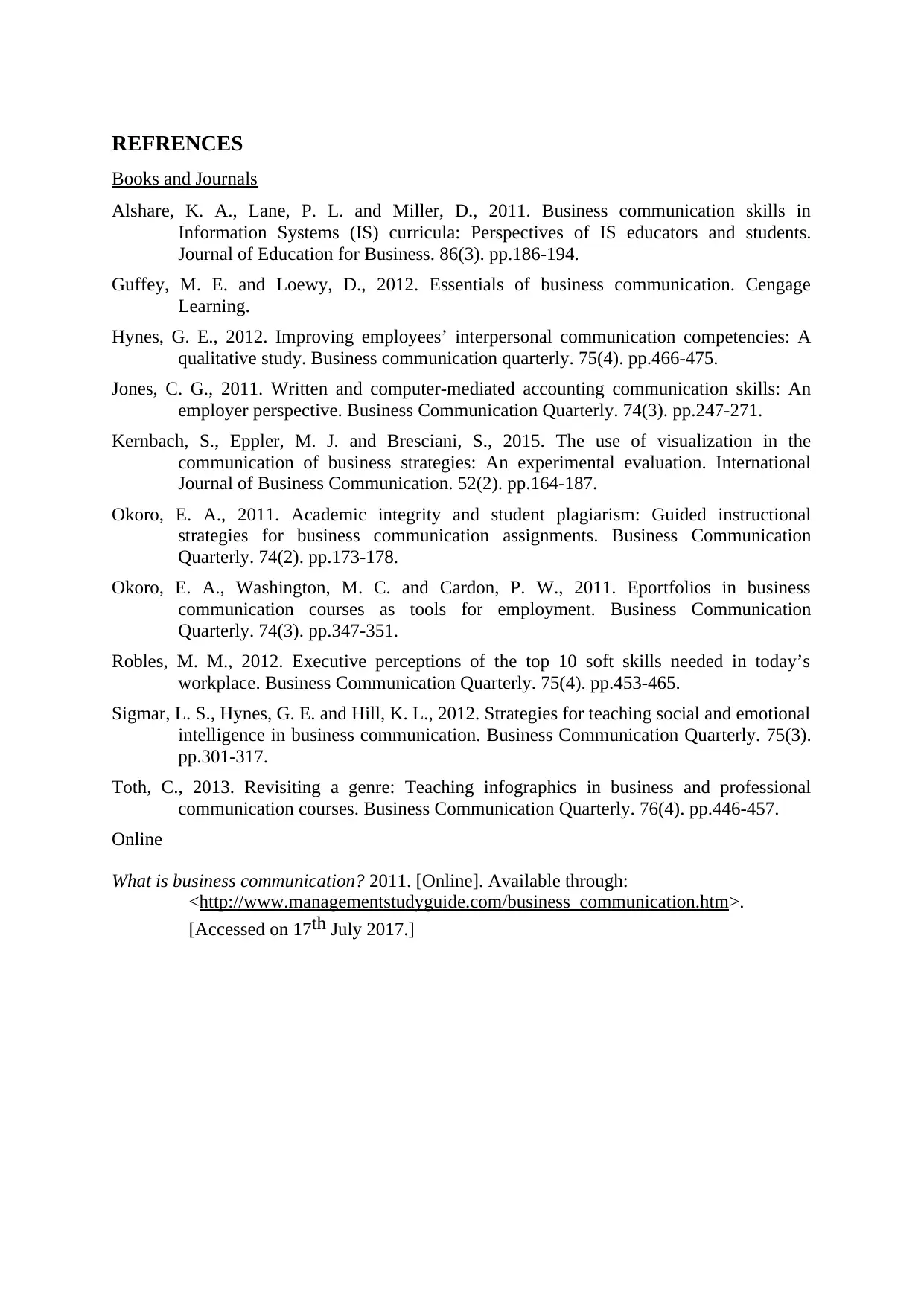
REFRENCES
Books and Journals
Alshare, K. A., Lane, P. L. and Miller, D., 2011. Business communication skills in
Information Systems (IS) curricula: Perspectives of IS educators and students.
Journal of Education for Business. 86(3). pp.186-194.
Guffey, M. E. and Loewy, D., 2012. Essentials of business communication. Cengage
Learning.
Hynes, G. E., 2012. Improving employees’ interpersonal communication competencies: A
qualitative study. Business communication quarterly. 75(4). pp.466-475.
Jones, C. G., 2011. Written and computer-mediated accounting communication skills: An
employer perspective. Business Communication Quarterly. 74(3). pp.247-271.
Kernbach, S., Eppler, M. J. and Bresciani, S., 2015. The use of visualization in the
communication of business strategies: An experimental evaluation. International
Journal of Business Communication. 52(2). pp.164-187.
Okoro, E. A., 2011. Academic integrity and student plagiarism: Guided instructional
strategies for business communication assignments. Business Communication
Quarterly. 74(2). pp.173-178.
Okoro, E. A., Washington, M. C. and Cardon, P. W., 2011. Eportfolios in business
communication courses as tools for employment. Business Communication
Quarterly. 74(3). pp.347-351.
Robles, M. M., 2012. Executive perceptions of the top 10 soft skills needed in today’s
workplace. Business Communication Quarterly. 75(4). pp.453-465.
Sigmar, L. S., Hynes, G. E. and Hill, K. L., 2012. Strategies for teaching social and emotional
intelligence in business communication. Business Communication Quarterly. 75(3).
pp.301-317.
Toth, C., 2013. Revisiting a genre: Teaching infographics in business and professional
communication courses. Business Communication Quarterly. 76(4). pp.446-457.
Online
What is business communication? 2011. [Online]. Available through:
<http://www.managementstudyguide.com/business_communication.htm>.
[Accessed on 17th July 2017.]
Books and Journals
Alshare, K. A., Lane, P. L. and Miller, D., 2011. Business communication skills in
Information Systems (IS) curricula: Perspectives of IS educators and students.
Journal of Education for Business. 86(3). pp.186-194.
Guffey, M. E. and Loewy, D., 2012. Essentials of business communication. Cengage
Learning.
Hynes, G. E., 2012. Improving employees’ interpersonal communication competencies: A
qualitative study. Business communication quarterly. 75(4). pp.466-475.
Jones, C. G., 2011. Written and computer-mediated accounting communication skills: An
employer perspective. Business Communication Quarterly. 74(3). pp.247-271.
Kernbach, S., Eppler, M. J. and Bresciani, S., 2015. The use of visualization in the
communication of business strategies: An experimental evaluation. International
Journal of Business Communication. 52(2). pp.164-187.
Okoro, E. A., 2011. Academic integrity and student plagiarism: Guided instructional
strategies for business communication assignments. Business Communication
Quarterly. 74(2). pp.173-178.
Okoro, E. A., Washington, M. C. and Cardon, P. W., 2011. Eportfolios in business
communication courses as tools for employment. Business Communication
Quarterly. 74(3). pp.347-351.
Robles, M. M., 2012. Executive perceptions of the top 10 soft skills needed in today’s
workplace. Business Communication Quarterly. 75(4). pp.453-465.
Sigmar, L. S., Hynes, G. E. and Hill, K. L., 2012. Strategies for teaching social and emotional
intelligence in business communication. Business Communication Quarterly. 75(3).
pp.301-317.
Toth, C., 2013. Revisiting a genre: Teaching infographics in business and professional
communication courses. Business Communication Quarterly. 76(4). pp.446-457.
Online
What is business communication? 2011. [Online]. Available through:
<http://www.managementstudyguide.com/business_communication.htm>.
[Accessed on 17th July 2017.]
1 out of 8
Related Documents
Your All-in-One AI-Powered Toolkit for Academic Success.
+13062052269
info@desklib.com
Available 24*7 on WhatsApp / Email
![[object Object]](/_next/static/media/star-bottom.7253800d.svg)
Unlock your academic potential
Copyright © 2020–2025 A2Z Services. All Rights Reserved. Developed and managed by ZUCOL.





